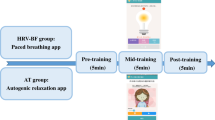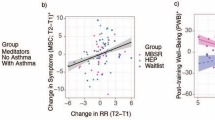Abstract
Heart rate variability biofeedback (HRVB) is a behavioral intervention that uses resonance frequency breathing to synchronize the heart rate and breathing patterns. This study aimed to explore how many sessions of wearable HRVB devices are needed to increase the HRV index and decrease breathing rates and to compare the HRVB protocol with other psychological intervention programs in HRV indices and breathing rates. Sixty-four participants were randomly assigned to either the HRVB or relaxation training (RT) group. Both groups received interbeat intervals (IBIs) and breathing rates measurement at the pre-training baseline, during training, and post-training baseline from weeks 1 to 4. IBIs were transformed into HRV indices as the index of the autonomic nervous system. The Group × Week interaction effects significantly in HRV indices and breathing rates. The between-group comparison found a significant increase in HRV indices and decreased breathing rates in the HRVB group than in the RT group at week 4. The within-session comparison in the HRVB group revealed significantly increased HRV indices and decreased breathing rates at weeks 3 and 4 than at weeks 1 and 2. There was a significant increase in HRV indices and a decrease in breathing rates at mid- and post-training than pre-training in the HRVB group. Therefore, 4 weeks of HRVB combined with a wearable device are needed in increasing HRV indices and decrease breathing rates compared to the relaxation training. Three weeks of HRVB training are the minimum requirement for increasing HRV indices and reducing breathing rates compared to the first week of HRVB.




Similar content being viewed by others
References
Bernardi, L., Porta, C., Spicuzza, L., Bellwon, J., Spadacini, G., Frey, A. W., Yeung, L. Y. C., Sandereson, J. E., Pedretti, R., & Tramarin, R. (2002). Slow breathing increases arterial baroreflex sensitivity in patients with chronic heart failure. Circulation, 105(2), 143–145. https://doi.org/10.1161/hc0202.103311
Billman, G. E. (2013). The LF/HF ratio does not accurately measure cardiac sympatho-vagal balance. Frontiers in Physiology, 4, 26. https://doi.org/10.3389/fphys.2013.00026
Chen, H. Y. (2000). Beck Depression Inventory Version II (Chinese version). Chinese Behavioral Science Corporation.
Del Pozo, J. M., Gevirtz, R. N., Scher, B., & Guarneri, E. (2004). Biofeedback treatment increases heart rate variability in patients with known coronary artery disease. American Heart Journal, 147(3), 545. https://doi.org/10.1016/j.ahj.2003.08.013
Gerritsen, R. J., & Band, G. P. (2018). Breath of life: The respiratory vagal stimulation model of contemplative activity. Frontiers in Human Neuroscience, 12, 397. https://doi.org/10.3389/fnhum.2018.00397
Goessl, V. C., Curtiss, J. E., & Hofmann, S. G. (2017). The effect of heart rate variability biofeedback training on stress and anxiety: A meta-analysis. Psychological Medicine, 47(15), 2578–2586. https://doi.org/10.1017/S0033291717001003
Goldstein, D. S., Bentho, O., Park, M. Y., & Sharabi, Y. (2011). LF power of heart rate variability is not a measure of cardiac sympathetic tone but may be a measure of modulation of cardiac autonomic outflows by baroreflexes. Experimental Physiology, 96(12), 1255–1261. https://doi.org/10.1113/expphysiol.2010.056259
Han, L., Zhang, Q., Chen, X., Zhan, Q., Yang, T., & Zhao, Z. (2017). Detecting work-related stress with a wearable device. Computer in Industry, 90, 42–49. https://doi.org/10.1016/j.compind.2017.05.004
Henriques, G., Keffer, S., Abrahamson, C., & Horst, S. J. (2011). Exploring the effectiveness of a computer-based heart rate variability biofeedback program in reducing anxiety in college students. Applied Psychophysiology and Biofeedback, 36(2), 101–112. https://doi.org/10.1007/s10484-011-9151-4
Huang, C., Gevirtz, R. N., Onton, J., & Criado, J. R. (2018). Investigation of vagal afferent functioning using the Heartbeat Event Related Potential. International Journal of Psychophysiology, 131, 113–123. https://doi.org/10.1016/j.ijpsycho.2017.06.007
Kanji, N., White, A. R., & Ernst, E. (2004). Autogenic training reduces anxiety after coronary angioplasty: A randomized clinical trial. American Heart Journal, 147(3), 508. https://doi.org/10.1016/j.ahj.2003.10.011
Karavidas, M. K., Lehrer, P. M., Vaschillo, E., Vaschillo, B., Marin, H., Buyske, S., Malinovsky, I., Radvanski, D., & Hassett, A. (2007). Preliminary results of an open label study of heart rate variability biofeedback for the treatment of major depression. Applied Psychophysiology and Biofeedback, 32(1), 19–30. https://doi.org/10.1007/s10484-006-9029-z
Koenig, J., & Thayer, J. F. (2016). Sex differences in healthy human heart rate variability: A meta-analysis. Neuroscience & Biobehavioral Reviews, 64, 288–310. https://doi.org/10.1016/j.neubiorev.2016.03.007
Laborde, S., Mosley, E., & Thayer, J. F. (2017). Heart rate variability and cardiac vagal tone in psychophysiological research-recommendations for experiment planning, data analysis, and data reporting. Frontiers in Physiology, 8, 213. https://doi.org/10.3389/fpsyg.2017.00213
Lee, J., Kim, J. K., & Wachholtz, A. (2015). The benefit of heart rate variability biofeedback and relaxation training in reducing trait anxiety. Hanguk Simni Hakhoe Chi Kongang, 20(2), 391–408. https://doi.org/10.1007/s10484-007-9043-9
Lehrer, P. M., & Gevirtz, R. (2014). Heart rate variability biofeedback: How and why does it work? Frontiers Physiology, 5, 756. https://doi.org/10.3389/fpsyg.2014.00756
Lehrer, P. M., Vaschillo, E., & Vaschillo, B. (2000). Resonant frequency biofeedback training to increase cardiac variability: Rationale and manual for training. Applied Psychophysiology and Biofeedback, 25(3), 177–191. https://doi.org/10.1023/A:1009554825745
Lehrer, P. M., Vaschillo, E., Vaschillo, B., Lu, S. E., Eckberg, D. L., Edelberg, R., Shih, W. J., Lin, Y., Kuusela, T. A., Tahvanainen, K. U. O., & Hamer, R. M. (2003). Heart rate variability biofeedback increases baroreflex gain and peak expiratory flow. Psychosomatic Medicine, 65(5), 796–805. https://doi.org/10.1097/01.PSY.0000089200.81962.19
Lehrer, P. M., Vaschillo, E., Vaschillo, B., Lu, S., Scardella, A., Siddique, M., & Habib, R. (2004). Biofeedback treatment for asthma. Chest, 126(2), 352–361. https://doi.org/10.1378/chest.126.2.352
Lim, S. J., & Kim, C. (2014). Effects of autogenic training on stress response and heart rate variability in nursing students. Asian Nursing Research, 8(4), 286–292. https://doi.org/10.1016/j.anr.2014.06.003
Lin, I. M. (2018). Effects of a cardiorespiratory synchronization training mobile application on heart rate variability and electroencephalography in healthy adults. International Journal of Psychophysiology, 134, 168–177. https://doi.org/10.1016/j.ijpsycho.2018.09.005
Lin, I. M., Fan, S. Y., Lu, H. C., Lin, T. H., Chu, C. S., Kuo, H. F., Lee, C. S., & Lu, Y. H. (2015). Randomized controlled trial of heart rate variability biofeedback in cardiac autonomic and hostility among patients with coronary artery disease. Behaviour Research and Therapy, 70, 38–46. https://doi.org/10.1016/j.brat.2015.05.001
Lin, I. M., Wang, S. Y., Fan, S. Y., Peper, E., Chen, S. P., & Huang, C. Y. (2020). A single session of heart rate variability biofeedback produced greater increases in heart rate variability than autogenic training. Applied Psychophysiology and Biofeedback, 45(4), 343–350. https://doi.org/10.1007/s10484-020-09483-y
Lin, Y. J. (2000). Beck Anxiety Inventory (Chinese version). Chinese Behavioral Science Corporation.
Mitani, S., Fujita, M., Sakamoto, S., & Shirakawa, T. (2006). Effect of autogenic training on cardiac autonomic nervous activity in high-risk fire service workers for posttraumatic stress disorder. Journal of Psychosomatic Research, 60(5), 439–444. https://doi.org/10.1016/j.jpsychores.2005.09.005
Miu, A. C., Heilman, R. M., & Miclea, M. (2009). Reduced heart rate variability and vagal tone in anxiety: Trait versus state, and the effects of autogenic training. Autonomic Neuroscience, 145(1), 99–103. https://doi.org/10.1016/j.autneu.2008.11.010
Natarajan, A., Pantelopoulos, A., Emir-Farinas, H., & Natarajan, P. (2020). Heart rate variability with photoplethysmography in 8 million individuals: A cross-sectional study. The Lancet Digital Health, 2(12), e650–e657. https://doi.org/10.1016/S2589-7500(20)30246-6
Prinsloo, G. E., Derman, W. E., Lambert, M. I., & Rauch, H. L. (2013). The effect of a single session of short duration biofeedback-induced deep breathing on measures of heart rate variability during laboratory-induced cognitive stress: A pilot study. Applied Psychophysiology and Biofeedback, 38(2), 81–90. https://doi.org/10.1007/s10484-013-9210-0
Reiner, R. (2008). Integrating a portable biofeedback device into clinical practice for patients with anxiety disorders: Results of a pilot study. Applied Psychophysiology and Biofeedback, 33(1), 55–61. https://doi.org/10.1007/s10484-007-9046-6
Sakakibara, M., Takeuchi, S., & Hayano, J. (1994). Effect of relaxation training on cardiac parasympathetic tone. Psychophysiology, 31(3), 223–228. https://doi.org/10.1111/j.1469-8986.1994.tb02210.x
Schumann, A., Köhler, S., Brotte, L., & Bär, K. J. (2019). Effect of an 8-week smartphone-guided HRV-biofeedback intervention on autonomic function and impulsivity in healthy controls. Physiological Measurement, 40(6), 064001. https://doi.org/10.1088/1361-6579/ab2065
Shaffer, F., & Ginsberg, J. P. (2017). An overview of heart rate variability metrics and norms. Frontiers in Public Health, 5, 258. https://doi.org/10.3389/fpubh.2017.00258
Shaffer, F., & Meehan, Z. M. (2020). A practical guide to resonance frequency assessment for heart rate variability biofeedback. Frontiers in Neuroscience, 14(570400), 1–14. https://doi.org/10.3389/fnins.2020.570400
Sherlin, L., Muench, F., & Wyckoff, S. (2010). Respiratory sinus arrhythmia feedback in a stressed population exposed to a brief stressor demonstrated by quantitative EEG and sLORETA. Applied Psychophysiology and Biofeedback, 35(3), 219–228. https://doi.org/10.1007/s10484-010-9132-z
Task Force of the European Society of Cardiology the North American Society of Pacing Electrophysiology. (1996). Heart rate variability: Standards of measurement, physiological interpretation, and clinical use. Circulation, 93(5), 1043–1065.
Van Diest, I., Verstappen, K., Aubert, A. E., Widjaja, D., Vansteenwegen, D., & Vlemincx, E. (2014). Inhalation/exhalation ratio modulates the effect of slow breathing on hart rate variability and relaxation. Applied Psychophysiology and Biofeedback, 39(3–4), 171–180. https://doi.org/10.1007/s10484-014-9253-x
Wright, S., Courtney, U., & Crowther, D. (2002). A quantitative and qualitative pilot study of the perceived benefits of autogenic training for a group of people with cancer. European Journal of Cancer Care, 11(2), 122–130.
Yu, L. C., Lin, I. M., Fan, S. Y., Chien, C. L., & Lin, T. H. (2018). One-year cardiovascular prognosis of the randomized, controlled, short-term heart rate variability biofeedback among patients with coronary artery disease. International Journal of Behavioral Medicine, 25(3), 271–282.
Zhang, Z., Wang, W., Wang, B., Wu, H., Liu, H., & Zhang, Y. (2009). A prototype of wearable respiration biofeedback platform and its preliminary evaluation on cardiovascular variability [Poster presentation]. International Conference on Bioinformatics and Biomedical Engineering, Beijing, China.
Acknowledgements
We thank the Ministry of Science and Technology, Taiwan for research funding (Grant Number: MOST 104-2410-H-037-001). We would like to thank Sui-Pi Chen, Ph.D., and Ching-Yu Huang, Ph.D., at the Industrial Technology Research Institute, who assisted with the application and smartphone. We would especially like to thank the student assistants San-Yu Wang, Ying-Ju Chen, Ya-Ting Hung, Hsin-Yi Lin, and Chia-I Ko for data collection.
Funding
This study was supported by the Ministry of Science and Technology of Taiwan (Grant Number: MOST 104-2410-H-037-001).
Author information
Authors and Affiliations
Corresponding author
Ethics declarations
Conflict of interest
I-Mei Lin received a research grant from the Ministry of Science and Technology of Taiwan. The authors declare that they have no conflicts of interest.
Human and Animal Rights and Informed Consent
All procedures were in accordance with the ethical standards of the responsible committee on human experimentation (institutional and national) and with the Helsinki Declaration of 1975, as revised in 2000. Informed consent was obtained from all the patients included in the study.
Additional information
Publisher's Note
Springer Nature remains neutral with regard to jurisdictional claims in published maps and institutional affiliations.
Rights and permissions
Springer Nature or its licensor (e.g. a society or other partner) holds exclusive rights to this article under a publishing agreement with the author(s) or other rightsholder(s); author self-archiving of the accepted manuscript version of this article is solely governed by the terms of such publishing agreement and applicable law.
About this article
Cite this article
Lin, IM., Chen, TC., Tsai, HY. et al. Four Sessions of Combining Wearable Devices and Heart Rate Variability (HRV) Biofeedback are Needed to Increase HRV Indices and Decrease Breathing Rates. Appl Psychophysiol Biofeedback 48, 83–95 (2023). https://doi.org/10.1007/s10484-022-09567-x
Accepted:
Published:
Issue Date:
DOI: https://doi.org/10.1007/s10484-022-09567-x




